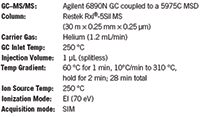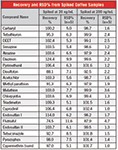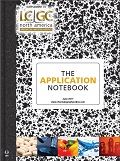Determination of Pesticides in Coffee with QuEChERS Extraction and Silica Gel SPE Cleanup
The Application Notebook
Summary
Coffee is one of the most widely consumed beverages in the world, partly due to the stimulating effect of its caffeine content. Like most crops, the application of pesticides in coffee cultivation is a common practice in order to increase production yields. This application details an optimized method for the extraction and cleanup of pesticide residues from coffee using a QuEChERS extraction procedure followed by a silica gel SPE cleanup.

Procedure
1. Sample Extraction:
a) Add 10 mL brewed coffee (pH adjusted to about 8 with 1 N NaOH) and 10 mL acetonitrile (MeCN) to a 50-mL centrifuge tube.
b) Add the QuEChERS extraction salts from the Mylar pouch (ECMSSC50CT-MP) to the 50-mL tube, and shake vigorously for 1 min manually or using a Spex 2010 Geno-Grinder at 1000 strokes/min.
c) Centrifuge at ≥3000 rcf for 5 min.
d) Transfer 5 mL supernatant to a clean test tube, add 1.5 mL toluene, and evaporate to about 1 mL.
2. Sample Clean-Up of Extract
a) Add about 1/2 inch of anhydrous sodium sulfate to a silica gel SPE cartridge (CUSIL156), and attach the SPE cartridge to a glass block or positive pressure manifold.
b) Wash the SPE cartridge with 6 mL dichloromethane, soak for 1 min, drain to waste, and dry the SPE cartridge for 1 min under full vacuum or pressure.
c) Condition the SPE cartridge with 2 × 6 mL hexane by gravity.
d) Insert glass collection container into the manifold, load the 1 mL concentrated sample onto the SPE cartridge, rinse the test tube with 6 mL of 15% acetone in n-hexane and apply the rinsate to the SPE cartridge, and collect.
e) Continue to elute with 3 × 6 mL of 15% acetone in n-hexane by gravity.
f) Add 1.5 mL ethyl acetate to the eluate container and evaporate to 1 mL.
g) Add internal standard, vortex for 30 s, and inject 1 µL into the GC-MS for analysis.
Instrumental

Results


UCT, LLC
2731 Bartram Rd., Bristol, PA 19007
tel. (800) 385-3153
Website: www.unitedchem.com


.png&w=3840&q=75)

.png&w=3840&q=75)



.png&w=3840&q=75)



.png&w=3840&q=75)











